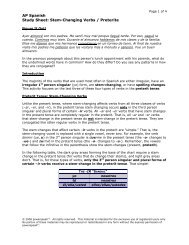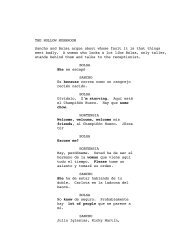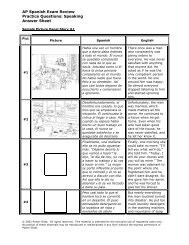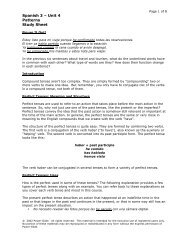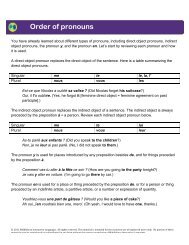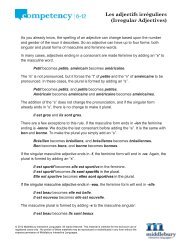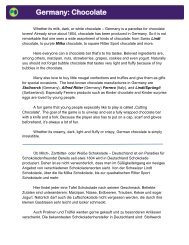Spanish 3 – Unit 2, Lesson 8 Patterns Study Sheet
Spanish 3 – Unit 2, Lesson 8 Patterns Study Sheet
Spanish 3 – Unit 2, Lesson 8 Patterns Study Sheet
You also want an ePaper? Increase the reach of your titles
YUMPU automatically turns print PDFs into web optimized ePapers that Google loves.
<strong>Spanish</strong> 3 <strong>–</strong> <strong>Unit</strong> 2, <strong>Lesson</strong> 8<br />
<strong>Patterns</strong><br />
<strong>Study</strong> <strong>Sheet</strong><br />
Page 2 of 5<br />
Demonstrative Adjective Practice Exercise: Translate the word in quotes. Make sure it<br />
agrees with the noun.<br />
1. “this” casa<br />
2. “these” fresas<br />
3. “this” teléfono<br />
3. “that” libro<br />
4. “those” hombres<br />
5. “that” chica<br />
6. “those” chicos<br />
7. “those” manzanas (over there, or far away)<br />
8. “that” señor (over there, or far away)<br />
Now, scroll down and check your answers.<br />
1. esta casa <strong>–</strong> notice that esta is feminine because casa is feminine<br />
2. estas fresas <strong>–</strong> notice that estas is feminine and plural<br />
3. este teléfono <strong>–</strong> notice that the masculine singular form ends in a “e” not “o”<br />
4. ese libro <strong>–</strong> ese means that, still close to the speaker<br />
5. esa chica <strong>–</strong> esa ends in an “a” because chica is feminine<br />
6. esos chicos <strong>–</strong> notice that the noun is masculine and plural<br />
7. aquellas manzanas <strong>–</strong> feminine & plural, the apples are farther from the speaker<br />
8. aquel señor <strong>–</strong> the man is far from the speaker<br />
Demonstrative Pronouns<br />
Pronouns take the place of nouns. So, what are demonstrative pronouns?<br />
Demonstrative pronouns look just like demonstrative adjectives except that they have a<br />
written accent mark on the first é. The accent replaces the noun.<br />
—Yo quiero aquella pera grande. I want that big pear.<br />
—¿Cuál? ¿Ésta? Which one? This one?<br />
—No. Ésa. La verde a la izquierda. No. That one. The green one on the left.<br />
In the brief dialogue above between a customer and a produce merchant, the accent over<br />
ésta and ésa replaced the word pera. There was no need to repeat “pera” because both<br />
speakers knew what item they were talking about. Notice that in English we typically use<br />
the word “one” instead of an accent mark.<br />
SPANISH<br />
DEMONSTRATIVE PRONOUNS<br />
Number<br />
Singular Plural<br />
Masc. Fem. Masc. Fem.<br />
THIS (one), THESE (ones) éste ésta éstos éstas<br />
THAT (one), THOSE (ones) ése ésa ésos ésas<br />
THAT (one) over there,<br />
THOSE (ones) over there<br />
áquél aquélla aquéllos aquéllas<br />
© 2006 Power-Glide. All rights reserved. This material is intended for the exclusive use of registered users only.<br />
No portion of these materials may be reproduced or redistributed in any form without the express permission of<br />
Power-Glide.




